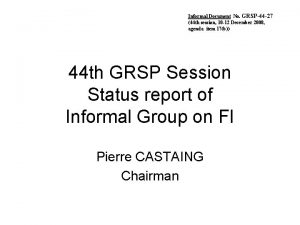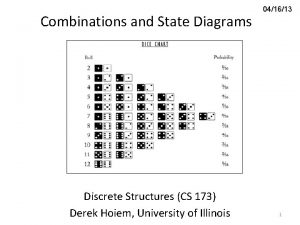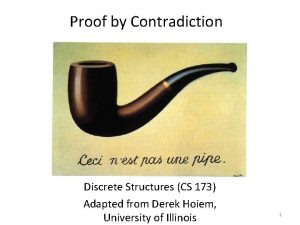Informal document WP 29 173 XX 173 rd







- Slides: 7

Informal document WP. 29 -173 -XX 173 rd WP. 29, 14 -17 November 2017 Agenda item x. y. Transmitted by the GRE Chairman SLR-21 -07 Mandatory Application of the Unique Identifier (UI) in the Simplified Lighting and Light –Signalling Regulations dule 5 3 of t n o i s i v e R Rev. 3 e 5 0 5 S N A E-ECE-TR he 19 - Sche t n e m e e r 58 Ag

Mandatory Application of the Unique Identifier (UI) in the Simplified Lighting and Light –Signalling Regulations GRE has concluded that it is necessary to implement the Unique Identifier (UI) as a mandatory requirement to replace the conventional type approval markings If the type approvals applicable to a wheeled vehicles, equipment or parts are stored on the secure internet database, then the approval markings required by UN Regulations may be replaced by a Unique Identifier (UI) preceded by the symbol , unless specified otherwise in the UN Regulations. Such unique identifier shall be generated by the database automatically.

Why do we need the Unique Identifier marking solution? • The use of the "Unique Identifier“ has been foreseen since June 2012 when WP 29 launched the simplification activity. (ECE-TRANS-WP 29 -2012 -119). • Mandatory use of Unique Identifier is a prerequisite for an effective transition towards the simplified lighting and light-signalling regulations. • The principle of grouping a number of devices into a single regulation is not compatible with the use of detailed approval markings on devices • With different markings for each device within one regulation the traditional marking becomes extremely complicated. This will be even more critical in the case of minimum performance based requirements (Phase 2 SLR). • Use of an electronic system of UI is a clear benefit compared to E-marking paper version processing. TAAs will be in position to identify the level of product compliance and performance more easily and will be able to relate it to products certified in different certification environments. 3

Why do we need the Unique Identifier marking solution? Example of a CONVENTIONAL grouped approval marking for a device combining functions type approved to the new LSD and RID and RRD Regulations. Indication of driving beam performance Low/High beam headlamp Front position lamp Daytime Running Lamp HCR -20 RL F 3 A 1 b IA XXX R 03 -22179 YYY R 04 -22179 ZZZ R 00 -22179 E 4 Note: A type approval marking involving an AFS system would be far more complicated Front Fog lamp Side retro-reflector Front direction Indicator lamp LSD Regulation series 03 RID Regulation series 04 RRD Regulation series 00 Approval number 22179 4

Why do we need the Unique Identifier marking solution? Example of a CONVENTIONAL grouped approval marking for a device combining functions type approved to the new LSD and RID and RRD Regulations. Indication of driving beam performance Low/High beam headlamp Front position lamp Note: This grouped marking would be replaced by Daytime Running Lamp HCR -20 RL F 3 A 1 b IA XXX R 03 -22179 YYY R 04 -22179 ZZZ R 00 -22179 E 4 Note: A type approval marking involving an AFS system would be far more complicated Front Fog lamp Side retro-reflector Front direction Indicator lamp LSD Regulation series 03 RID Regulation series 04 RRD Regulation series 00 Approval number 22179 5

Why do we need the Unique Identifier marking solution? EXAMPLE OF A CONVENTIONAL APPROVAL MARK OF A SINGLE ROAD ILLUMINATION DEVICE Due to the size of this marking the optical working surface would be distorted, with the result of non-compliance of the photometric performance. Consequently the commercial exploitation of this device as a contributor to AFS systems is not possible. The only visible part of the device when the lamp is fitted on the vehicle is the lens (80% optical area) Ø 60 mm ALL this CONVENTIONAL marking shall be visible when the lamp is fitted on the vehicle 6

Why do we need the Unique Identifier marking solution? 45 mm CONVENTIONAL APPROVAL MARK OF A SINGLE ROAD ILLUMINATION DEVICE Due to the size of this marking the optical working surface would be distorted, with the result of non-compliance of the photometric performance. Consequently the commercial exploitation of this device as a contributor to AFS systems is not possible. ALL this CONVENTIONAL marking shall be visible when the lamp is fitted on the vehicle 35 mm (or more) EXAMPLE OF A The only visible part of the device when the lamp is fitted on the vehicle is the lens (80% optical area) Ø 60 mm These markings would be replaced by the UI 7













